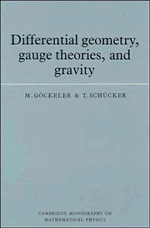Book contents
- Frontmatter
- Contents
- Preface
- 1 Exterior algebra
- 2 Differential forms on open subsets of ℝn
- 3 Metric structures
- 4 Gauge theories
- 5 Einstein–Cartan theory
- 6 The Lie derivative
- 7 Manifolds
- 8 Lie groups
- 9 Fibre bundles
- 10 Monopoles, instantons, and related fibre bundles
- 11 Spin
- 12 An algebraic approach to anomalies
- 13 Anomalies from graphs
- References
- Bibliography
- Notation
- Index
12 - An algebraic approach to anomalies
Published online by Cambridge University Press: 04 April 2011
- Frontmatter
- Contents
- Preface
- 1 Exterior algebra
- 2 Differential forms on open subsets of ℝn
- 3 Metric structures
- 4 Gauge theories
- 5 Einstein–Cartan theory
- 6 The Lie derivative
- 7 Manifolds
- 8 Lie groups
- 9 Fibre bundles
- 10 Monopoles, instantons, and related fibre bundles
- 11 Spin
- 12 An algebraic approach to anomalies
- 13 Anomalies from graphs
- References
- Bibliography
- Notation
- Index
Summary
Anomalies are said to occur when symmetries of a classical theory are broken by quantum corrections. This breaking may be welcome as in the case of some approximate rigid symmetries. For example the axial U(1)-anomaly permits us to understand the π0 decay into two photons. We shall be concerned only with the opposite case of ‘sacred’ symmetries necessary for consistency. The most prominent examples are gauge symmetries of quantized Yang–Mills theories in four-dimensional Minkowski space. Here the gauge symmetry ensures unitarity. Therefore one insists on vanishing anomalies which puts nontrivial constraints on the possible matter content, especially in the sector of chiral fermions. Continuous symmetries fall into two categories: the infinitesimal transformations, close to the identity of the symmetry group, and the global transformations. Anomalies of global transformations are more difficult to compute (Witten 1985) than infinitesimal anomalies, which we shall consider. Anomalies are defined in the context of quantum theory. Quantization of a field theory is beyond the scope of this text. However, there is a purely algebraic algorithm classifying infinitesimal anomalies, which is the subject of this chapter. Chapter 13 collects some explicit results of anomaly calculations via Feynman graphs.
- Type
- Chapter
- Information
- Differential Geometry, Gauge Theories, and Gravity , pp. 201 - 211Publisher: Cambridge University PressPrint publication year: 1987



